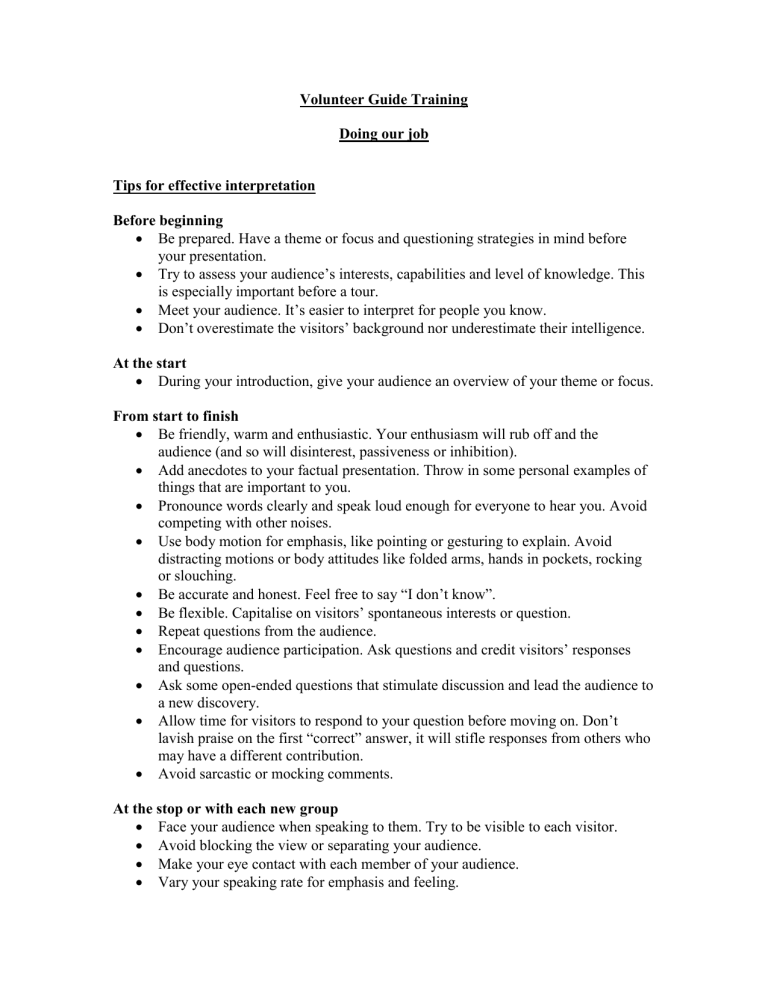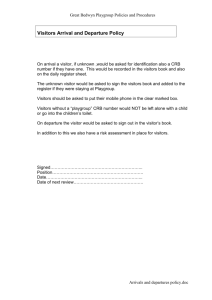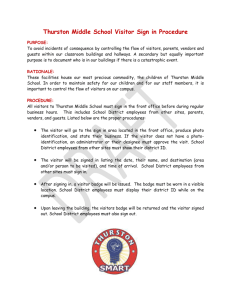Volunteer Guide Training

Volunteer Guide Training
Doing our job
Tips for effective interpretation
Before beginning
Be prepared. Have a theme or focus and questioning strategies in mind before your presentation.
Try to assess your audience’s interests, capabilities and level of knowledge. This is especially important before a tour.
Meet your audience. It’s easier to interpret for people you know.
Don’t overestimate the visitors’ background nor underestimate their intelligence.
At the start
During your introduction, give your audience an overview of your theme or focus.
From start to finish
Be friendly, warm and enthusiastic. Your enthusiasm will rub off and the audience (and so will disinterest, passiveness or inhibition).
Add anecdotes to your factual presentation. Throw in some personal examples of things that are important to you.
Pronounce words clearly and speak loud enough for everyone to hear you. Avoid competing with other noises.
Use body motion for emphasis, like pointing or gesturing to explain. Avoid distracting motions or body attitudes like folded arms, hands in pockets, rocking or slouching.
Be accurate and honest. Feel free to say “I don’t know”.
Be flexible. Capitalise on visitors’ spontaneous interests or question.
Repeat questions from the audience.
Encourage audience participation. Ask questions and credit visitors’ responses and questions.
Ask some open-ended questions that stimulate discussion and lead the audience to a new discovery.
Allow time for visitors to respond to your question before moving on. Don’t lavish praise on the first “correct” answer, it will stifle responses from others who may have a different contribution.
Avoid sarcastic or mocking comments.
At the stop or with each new group
Face your audience when speaking to them. Try to be visible to each visitor.
Avoid blocking the view or separating your audience.
Make your eye contact with each member of your audience.
Vary your speaking rate for emphasis and feeling.
Vary the amount of talking per stop, topic etc.
Do what you want your audience to do, like bending over to look at something more closely or picking up an interesting animal.
Encourage visitors to use several senses (seeing, hearing, touch and smell) during your presentation.
Know when to be silent.
Watch for, and respond to, audience feedback. Verbal contributions, questions, a head nod (not sleepy kind), laughter and applause indicate the audience is with you.
Fidgeting, blank stares or apparent confusion indicate that you aren’t getting through to your audience.
Use transitions to connect one topic (or place) to another.
In the end
Conclude your presentation. Summarise major points and congenially release your audience. Suggest other exhibits that might interest them or that they shouldn’t miss.
What is interpretation?
Here are three ways of interpreting the same animal. What do you think of them?
VISITOR:
What’s that?
GUIDE: A gumboot chiton.
VISITOR: Oh.
VISITOR: What’s that?
GUIDE: A gumboot chiton. Like other chitons it has eight valves or plates. Unlike other chitons, the gumboot chiton’s plates are under the mantle. They look like these butterfly shells.
VISITOR: Oh.
GUIDE: A gumboot chiton is a kind of mollusc. It lives on the rocks along the coast and grazes on algae.
VISITOR: Hmmmmmm.
GUIDE: Molluscs are a group of animals that includes snails, clams and so forth.
VISITOR: Oh, a snail. Thank you.
VISITOR:
Uuch, what’s that?
GUIDE:
It does look like a little weird but it’s related to snails, like an abalone. Let me show you something. If I turn it over you can see gills, mouth and foot.
Go ahead and touch it.
VISITOR: Ooooh. What does it do?
GUIDE: It scrapes plants (algae) off rocks. In its mouth is a ribbonlike file covered with teeth, called radula. We also know algae live on it and small pea crabs use it as a home. Can you see one living in its gills?
VISITOR:
Oh yeah. If it’s like a snail, where’s its shell?
GUIDE: It has eight butterfly-shaped shells or plates along the back. You can’t see them because they’re covered by the mantle, but you can feel them. You can’t see them because they’re covered by the mantle, but you can feel them. They look like this (showing a chiton plate). Have you ever seen shells like these on the beach?
VISITOR: What do you call it?
GUIDE:
It’s a gumboot chiton – the largest chiton in the world. If you’ve done any tide pooling you may be more familiar with the lined shore chiton. Have you ever seen one of these (showing a lined shore chiton) on the rocks?
Good interpretation capitalises on curiosity and helps visitors see meanings and relationships rather than simply learning facts. It involves listening, sharing, seeing through the visitor’s eyes, acting on feedback, having fun, learning and teaching. In the 1950’s Freeman Tilden wrote a book on the fundamentals of interpretation. Since then Interpreting Our Heritage has become the basic guide to interpretation. Here are Tilden’s six principles of interpretation.
1.
Interpretation that doesn’t relate to the visitor sterile. (Start your interpretation with visitors’ reactions)
2.
Interpretation is a revelation based upon information. Information, as such, is not interpretation. (What fore an “oh!” – that is your signal as a guide to step in and interpret what the visitors is reacting to.)
3.
Interpretation is an art, which combines many arts, whether the materials presented are scientific, historical, architectural, or otherwise. (let your strengths and talents show.)
4.
The chief aim of interpretation is not instruction, but provocation. (You should be asking questions as well as answering them.)
5.
Interpretation should aim to present a whole rather than a part. (Show the visitors the forest as well as the trees.)
6.
Interpretation for children should follow a fundamentally different approach than interpretation for adults. (Instead of giving a diluted adult presentation, develop a hands-on, experiential children’s presentation.)
Questions and Responses
Questions can be a tool, too
In addition to giving the responses, you can ask questions to. You may think, “Why ask questions: shouldn’t I be answering them?” Questions can be a very valuable interpretative tool. You can use questions to:
Stimulate conversation
Find out more about visitors
Focus visitors’ attention
Actively involve visitors in creative and critical thinking
Encourage visitors to ask questions they have
Encourage visitors to look, discover and learn
You can different kinds of questions
What kinds of questions should you ask? There are three basic kinds of questions: recall, process ad application.
Recall questions draw out past experiences, feelings or observations. A recall question asks the visitor to recall, identify or describe something he or she has observed or is observing directly. Recall questions engage at the lowest level of meaning and thinking.
Process questions help visitors discover relationships. A process question asks the visitor to compare, classify, sequence, infer or explain. Process questions help visitors see relationships among the facts; they require a higher level of thinking.
Application questions have visitors use information in a new or hypothetical situation.
An application question asks the visitor to evaluate, extrapolate, predict, imagine or invent. Application questions involve the visitors in the highest level of thinking.
Use all three kinds of questions
Start with recall questions, and then ask process questions that build on answers to earlier questions. Ask application questions last. Recall questions are simpler, application questions are more complex. Visitors must gather information before they can process it and must process it before they can apply it.
After asking a question, count to five before saying anything. This gives the person time to think.
Pose questions with care. If you ask too many questions or if your questions are confusing, visitors will not respond the way you want or will stop responding.
Listen to answers. People say surprising things and they can give you a fresh look at the familiar.
Credit answers with a “great” or “that’s a good idea” or “I never thought of that”.
Don’t take the first right answer. Credit the first answer then do some exploring.
Ask for other responses: “Anyone has any other ideas?” or “Are there any other possibilities?”
Relate questions to the theme of your tour or the focus of the exhibit.
Avoid questions that require a “yes” or “no” or “I don’t know” or single word answer. You are not quizzing the visitors; you’re trying to draw them out and start up a conversation.
Try to phrase questions so they don’t contain the answer.
Hand-held objects
Before you begin:
1.
Lay out all objects in the showing sequence.
2.
Be sure the background is suitable. The background should contrast with the object’s colour and shape.
3.
Position yourself in a well-lit area and so that everyone can see you.
During your talk:
1.
Let the visitor examine and handle the object being shown, if possible. Use extra caution with children.
2.
Handle live objects carefully and demonstrate proper handling techniques to the visitor.
3.
Handle any potentially unsafe or easily damaged object yourself.
4.
Hold the object steady. It’s difficult for those watching to see any detail if the object is moving.
5.
Turn the objects slowly. This will help the visitor grasp visual relationships.
6.
Point out the object’s features slowly. Use a point, if appropriate.
7.
If the object has use, show that use.
8.
Appeal to the viewer’s imagination where possible.
9.
Be sure tat everyone present can see what is being shown.
Interpreting for children
Children of all ages learn best if you get them involved with concrete objects, let them share their experiences and thoughts, listen to them and respect them as people.
Children apes 2 to 5
Have abundant energy, active bodies and short attention spans.
Lack fine muscle co-ordination and have difficulty holding objects.
Learn primarily though their sense and body movements
Are developing memory and vocabulary
Are beginning to classify
Find it hard to interrelate several things at one time
Are self-centred and have difficulty seeing situations from a perspective other than their own
Relate primarily to their mothers
Teaching strategies for children between the ages 2 to 5
Make use of their abundant energy and need to be active by playing body games: swaying like the kelp forest, pretending they are shorebirds picking and probing in the mud or moving their hands the way a fish or whale swims.
Limit your questions-asking. They often don’t have answers and the answers they do have often don’t pertain to your question.
Encourage the use of senses by asking them what the ocean smells and sounds like, what animals and plants feel like, or what they see in the exhibits. Encourage them to touch, listen, look and smell.
Always help them hold objects and don’t ask them to use the microscopes or spotting scopes by themselves. These instruments are sometimes difficult for them to operate.
Help them develop their memories and vocabulary by asking them to repeat the names of the plants and animals as you introduce them.
Describe relationships by using terms like baby, mother, father, helper, enemies, etc. At this age familiar terms work better than biological terms.
Children ages 6 to 9
Still need active moments.
Have better gross motor co-ordination and are developing fine motor coordination, but are still clumsy with precise tasks.
Have longer attention span, but still short (5-10 minutes).
Are beginning to think logically.
Need verbal descriptions or abstract ideas tied to concrete items they can manipulate.
Are just starting to make cause-effect associations.
Can group or classify objects.
Are building stronger relationships and loyalties with peer group.
Are beginning relationships with other adults.
View pair relationships as important.
Teaching strategies for children ages 6 to 9
You can use most of the body games listed for ages 2 to 5.
Hand them objects (or animals) to hold. Some of them may be able to use the spotting scopes or microscopes. Be patient and ready to help.
The younger students may enjoy working together. Use buddies or teams so you don’t lose anyone as you move through the museum.
Use their ability to see relationships.
Use questioning strategies to draw out observations, experiences and feelings.
Children ages 10 to 12
Vary widely in physical development and skills at this age.
Have increasing attention spans and finer motor co-ordination.
Desire activities requiring fine muscle co-ordination.
Are interested in learning new skills.
Are still concerned primarily with objects rather than ideas.
Are more adept at seeing cause-effect relationships, thinking logically and classifying.
Can verbalise curiosity and needs.
Are learning to cooperate and enjoy group activities.
Can mentally put themselves in another’s place.
Often see teachers and group leaders as parent substitutes.
Teaching strategies for children ages 10 to 12
Use the microscopes. They’ll challenge this group and these students have a god chance of succeeding.
Have them identify specific kinds of organisms or parts by using one or two key characteristics you give them.
Encourage them to touch and smell the animals.
Pose questions that encourage logical thinking or drawing cause-defect relationships.
After the tour, have the learners role-play the animals they’ve seen at the museum.
Give them a chance to ask you questions and share experiences at various exhibits.
Children ages 13 to 17
Grow and develop rapidly; this leads to a lack of fine motor co-ordination and awkwardness.
Seek specific and accurate information.
Are interested in ideas; ca think more abstractly with less need for concrete objects to manipulate.
Can think logically and develop theories and hypotheses to explain events.
Can group objects by several variables at the same time and can see and remember interrelationships more clearly; can see the parts as well as the whole.
Desire intellectual freedom.
Need peer group support.
Desire independence; testing adult relationships often leads to conflicts with adults.
May lack self-confidence although they seem physically mature.
Teaching strategies for ages 13 to 17
Expect to be challenged. You are an authority figure to them. Respect them and they will respect you.
Listen to their thoughts and opinions.
Ask questions (especially “why” and “what if” questions) of the group.
Acknowledge and credit all answers from students brave enough to speak up in front of peers.
If you get wrong information or if one of them does something you think is stupid, don’t single out or belittle that person. That may the group against you.
Let your sense of humour and individuality show. They will appreciate it.
Focus on other community and habitat interactions. Explain how the parts fit into the whole.
BOOK: Crafting and executive, concepts ad cases 14 th edition Thomsons by
Stricland and Gamble







